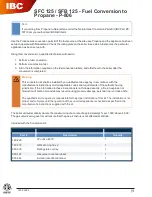
7
CHAPTER
2
CHAPTER 2 - COMBUSTION AIR & VENTING
In order to reduce the potential risks associat-
ed with indoor contaminates (see list in Section
2.1 on page 3), flammable vapors and tight
housing construction with little or no infiltration
air, it is recommended to pipe uncontaminated
combustion air directly from the outdoors to the
appliance. This practice also promotes higher
system efficiency by reducing heated indoor air
from being exhausted from the house and re-
placed by cold infiltration air into the house.
Verify installed combustion air and vent pip-
ing are sealed gas tight and meet all provided
instructions and applicable codes, failure to
comply will result in serious injury, or death.
Failure to properly support the vent system
can cause the venting system to fail, result-
ing in substantial property damage, serious
injury, or death.
Install combustion air and vent pipe as detailed
in the PRESTIGE Vent Supplement included in
the boiler installation envelope. Refer to op-
tional vent kit instructions for additional vent
installation instructions.
2.6. Removal of an Existing Boiler from a
Common Vent System
When an existing boiler is removed from a com-
mon venting system, the common venting system
is likely to be too large for proper venting of the re-
maining appliances. At the time of removal of an
existing boiler, the following steps shall be followed
with each appliance remaining connected to the
common venting system placed in operation, while
the other appliances remaining connected to the
common venting system are not in operation.
BEST PRACTICE
DANGER
WARNING
NOTICE
BEST PRACTICE
1. Seal any unused openings in the common venting
system.
2. Visually inspect the venting system for proper size
and horizontal pitch and determine there is no
blockage or restriction, leakage, corrosion and other
deficiencies which could cause an unsafe condition.
3. Insofar as is practical:
• Close all exterior building doors and windows
and all doors between the space in which the
appliances remaining connected to the com-
mon venting system are located and other
spaces of the building.
• Turn on clothes dryers and any appliance not
connected to the common venting system.
• Turn on any exhaust fans, such as range hoods
and bathroom exhausts, so they will operate at
maximum speed.
• Do not operate a summer exhaust fan.
• Close fireplace dampers.
4. Place in operation the appliance being inspected.
• Follow the lighting instructions.
• Adjust thermostat so appliance will operate
continuously.
5. Test for spillage at the draft hood relief opening
after 5 minutes of main burner operation. Use the
flame of a match or candle, or smoke from a ciga-
rette, cigar or pipe.
6. After it has been determined that each appliance
remaining connected to the common venting sys-
tem properly vents when tested as outlined above,
return doors, windows, exhaust fans, fireplace
dampers, and any other gas-burning appliance to
their previous condition of use.
7. Any improper operation of the common venting sys-
tem should be corrected so the installation conforms
with the National Fuel Gas Code (NFPA 54 / ANSI
Z223.1) for installations in the U.S. or CAN/CSA B149.1
for installations in Canada. When resizing any por-
tion of the common venting system, the common
venting system should be resized to approach the
minimum size as determined using the appropriate
tables in Chapter 13 of the National Fuel Gas Code
(NFPA 54 / ANSI Z223.1) for installations in the U.S. or
CAN/CSA B149.1 for installations in Canada.
Do not install the PRESTIGE Solo into a com-
mon vent with any other gas or oil appliances.
This will cause flue gas spillage or appliance
malfunction, resulting in substantial proper-
ty damage, serious injury, or death.
DANGER
Summary of Contents for PRESTIGE Solo PA 110
Page 2: ...INTENTIONALLY LEFT BLANK...
Page 10: ...INTENTIONALLY LEFT BLANK...
Page 22: ...INTENTIONALLY LEFT BLANK...
Page 36: ...INTENTIONALLY LEFT BLANK...
Page 44: ...INTENTIONALLY LEFT BLANK...
Page 52: ...INTENTIONALLY LEFT BLANK...
Page 74: ...INTENTIONALLY LEFT BLANK...
Page 76: ...INTENTIONALLY LEFT BLANK...
Page 80: ...INTENTIONALLY LEFT BLANK...
Page 82: ...INTENTIONALLY LEFT BLANK...
Page 84: ...INTENTIONALLY LEFT BLANK...
Page 111: ......
















































